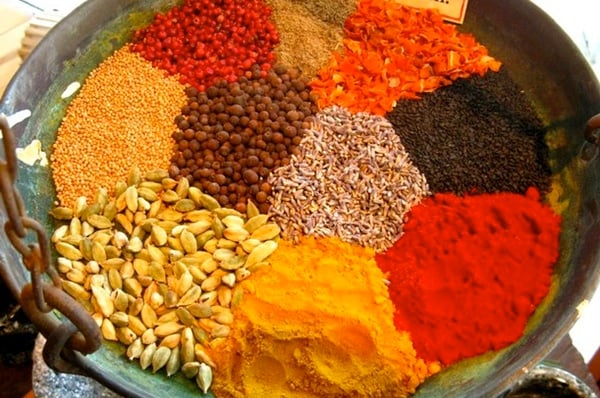Plenty of spices are great salt substitutes. Photograph courtesy of Flickr user srqpix.
We all know the dangers of fatty, cholesterol-laden fast foods. But there’s another diet destroyer lurking in even innocent-seeming items like deli meat and canned soup: excess sodium.
According to a new report released by the Centers for Disease Control (CDC), nine in ten Americans get too much sodium every day. The average person consumes about 3,300 milligrams of sodium daily, way over the recommended limit of 2,300 and more than double the recommendation for people ages 51 and up, African Americans, or anyone who suffers from high blood pressure, diabetes, or chronic kidney diseases.
Unfortunately, much of that sodium comes from processed foods, such as bread and lunch meat, and popular snacks such as chips and pretzels. A whopping 65 percent of it comes from food sold in stores, and another 25 percent comes from restaurant dishes.
The takeaway? Cook more from scratch. And don’t think you’re resigned to a life of bland meals: These tasty herbs and spices add so much flavor to a dish, you’ll never even miss the salt.
NUTRITIONAL YEAST
This inactive yeast is popular among vegetarians and vegans thanks to its cheese-like flavor and protein and vitamin content. It’s also sugar-, diary-, and gluten-free, and low in sodium and fat. Nutritionist Danielle Omar recommends sprinkling it over popcorn, soups, pasta, steamed veggies, and pizza.
CUMIN
A beloved component of Middle Eastern cuisine, cumin has a peppery flavor that adds zip to any dish. It’s also high in iron, is great for digestion, and may have cancer-fighting properties.
ROSEMARY
This herb’s savory taste and strong aroma perfectly complement meat dishes. Rosemary is high in iron, calcium, and B vitamins. Nutritionist Heather Calcote likes to use it in yogurt dips, lasagna, and with roasted potatoes and fish.
KAFFIR LIME LEAVES, LEMONGRASS, and STAR ANISE
These plants are common in Asian cuisines; you’re likely to taste them in curry paste, Thai dishes, and stews. They’re all favorite sodium substitutes for nutritionist and cook Robyn Webb.
THYME
Just two teaspoons of this aromatic herb contains 60 percent of your daily recommended intake of vitamin K, along with plenty of iron. Try it in pasta, pizza, and sprinkled on top of a stir-fry. Calcote also likes it in scrambled eggs, to “add a splash of favor to a pretty standard breakfast.”
CILANTRO and CORIANDER
These twin herbs come from the same plant—cilantro refers to the leaves, and coriander is the name for the seeds. Somewhat similar in taste, they both provide antioxidants and help with digestion.
GOMASIO
Made from ground, dry-roasted sesame seeds, this spice is “an excellent lower-sodium alternative to table salt,” says Elise Museles of Kale & Chocolate. It also contains magnesium, iron, protein, and fiber.
CAYENNE
To boost flavor without piling on the salt, nutritionist Elana Natker adds this pepper to savory, spice-friendly dishes such as chili. Thanks to its heat, cayenne will open your sinuses right up and impart a good dose of vitamin A.
TARRAGON
This herb is so strong that it tends to dominate a dish if used too generously. But nutritionist Katherine Tallmadge says it imparts a “lively flavor” when used in moderation, and is especially good when fresh. Also try basil and fresh garlic.


















